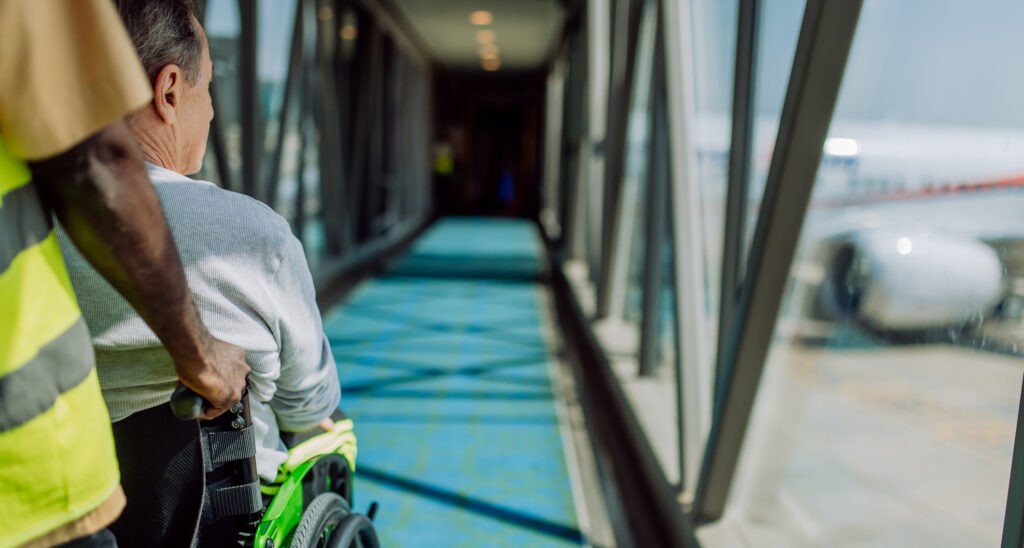Feds Mandate Bigger Airplane Bathrooms for Better Access
New aircraft must make room for wheelchairs, other amenities
By Evan Dougherty
Published August 7, 2023
Read Time: 3 mins
A new federal rule will soon increase the required size of lavatories on U.S. commercial passenger aircraft.
Driving the news: The Department of Transportation announced July 26 that it will require airlines to make lavatories on new single-aisle aircraft large enough to permit passengers with disabilities.
- The new rule, authorized by the Air Carriers Access Act, will require airlines to add at least one lavatory large enough to accommodate a passenger with a disability and attendant “both equivalent in size to a 95th percentile male, to approach, enter, and maneuver within as necessary to use the aircraft lavatory,” the agency said in a statement.
What this means: The DOT published the following guidelines for airline lavatories.
- Airlines must add accessibility features inside lavatories on new aircraft deliveries by 2026. All new planes ordered by 2033 or delivered by 2035 must have fully accessible lavatories equipped.
- Accessories to be added include grab bars, accessible faucets and controls, specialized call buttons and door locks. Updated lavatories must also be wide enough to accommodate wheelchairs.
- The rule covers new single-aisle aircraft configured with greater than 125 seats. This includes prominent aircraft types such as Airbus’s A220 and A320 family aircraft and Boeing’s 737 and 757 series. The DOT noted that widebody, twin-aisle aircraft already require accessible lavatories.
- The rule does not apply to lower-capacity regional jets, however, such as the Mitsubishi CRJ series and Embraer 175, and turboprop aircraft, types that are essential to serving smaller communities.
- In addition, airlines will be required to train staff on how to properly stow wheelchairs onboard and assist passengers to and from lavatories.

The DOT’s new rule covers single-aisle aircraft with greater than 125 seats, which includes popular types such as the Boeing 737. Regional aircraft, however, like the Embraer 175, are exempt from the rule. (Photo by Beth Hollerich)
What they’re saying: Transportation Secretary Pete Buttigieg championed the rule for its enhancements towards accessibility and ease of air travel for more of the public, reducing stress.
- “We are proud to announce this rule that will make airplane bathrooms larger and more accessible, ensuring travelers in wheelchairs are afforded the same access and dignity as the rest of the traveling public, Buttigieg said in a statement.
- Industry trade group Airlines for America, which represents U.S. airlines, affirmed its commitment to the rule in a statement: “U.S. airlines fully support accessible lavatories on single-aisle aircraft and have been voluntarily working with the disability community, the Department of Transportation and industry stakeholders for seven years on solutions.”
Accessibility efforts: In addition, the DOT and airlines have announced plans to make travel easier for fliers with a disability.
- The DOT’s new rule builds on the department’s first-ever bill of rights for travelers with disabilities (unveiled last year) and the Biden administration’s major investments in airport infrastructure. Under the Bipartisan Infrastructure Law, airport terminal modernization projects are including upgrades to accessibility, such as added wheelchair ramps, accessible restrooms and more.
- Last month, United Airlines became the first U.S. carrier to introduce Braille to its aircraft. United has begun retrofitting its aircraft with Braille and is expected to outfit its entire mainline fleet by late 2026.
- In addition, Delta Air Lines recently unveiled a new prototype seat to accommodate wheelchair passengers onboard. In conjunction with U.K.-based Air4All, Delta’s new seat allows passengers to remain in their wheelchair while still having access to in-seat amenities including headrests and a tray table. The seat design will undergo certification and testing before entering service.

Delta, last month, unveiled a new prototype seat in conjunction with Air4All that allows passengers to remain in their wheelchair while still having access to in-seat amenities including headrests and a tray table. (Image courtesy of Delta Air Lines)
Watch
This Next
Read
This Next






